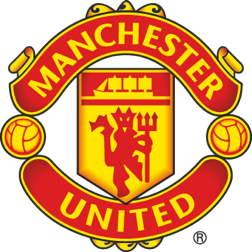Who are the Stone Roses?
The Manchester United x adidas x Stone Roses collection, launched on Thursday, will have many Reds nodding their heads in approval.
But let's not kid ourselves: the year 1989, when the iconoclastic group released their self-titled debut album – described by many as the greatest of all time – was 35 years ago.
Younger fans could be forgiven for rushing to Google or perhaps turning to a parent to ask: who exactly are the Stone Roses?
The simple answer is: Ian Brown (vocals), John Squire (guitar), Mani (bass) and Reni (drums, vocals) were four lads from Manchester who captivated the music scene in the late 1980s and early 1990s via an astonishing run of beautiful tunes.
But that's like summing up Sir Matt Busby's career by noting that he won a few football matches. It doesn't do any kind of justice to the level of passion that this band inspired, and continue to inspire, in millions of people around the world, both young and old.
So why are the Roses such a big deal, then?
Roses are Red Video
Roses are Red
Discover the story behind 'This Is The One', United's iconic stadium walk-out song by The Stone Roses...
It's a good question. After all, Manchester is not short of legendary music acts. Oasis, Happy Mondays, Joy Division, New Order, the Smiths, the Fall... and they're just the Mount Rushmore-level names.
But I'd argue that, for United fans, at least, the Stone Roses are the ultimate Manchester band. The GOAT, as the yute might say.
Speak to individuals and you'll get different opinions on that topic, of course. But you only have to travel to an away game on one of the supporters' coaches to realise how closely Reds associate with the Roses' music. Or read almost any issue of the much-admired fanzine United We Stand.
Each month, a diehard supporter is asked to answer a series of questions in a feature called 'They Bleed Red, White and Black'. One of the questions is 'What's your favourite album?' Having read that fanzine for more than 20 years, I'd estimate that a healthy 75 per cent of people answering have chosen the Roses' aforementioned debut.
The band might be from before your time, or maybe you're a supporter who hails from overseas, unfamiliar with UK music, but if you haven't heard this album, I urge you to head to your streaming service of choice and get it flowing immediately. It's one of the most perfect, cohesive and delicious stretches of audio you will ever hear. I Wanna Be Adored, She Bangs the Drums, Waterfall, Made of Stone, I Am the Resurrection – these are the Manchester anthems you’ll hear towards the end of the night at any decent indie club.
They’re addictive, euphoric slices of guitar-led pop. But it’s not just about guitars; the unique thing about the Roses is arguably the bass and drums. This is singalong indie that you can also dance to.
Part of the reason United fans identify with the Stone Roses is, undoubtedly, because three of the band's four members are Reds. (Oasis would be the Manchester City equivalent, with only guitarist Bonehead supporting us.)
Mani and Ian Brown are regular faces at Old Trafford and, of course, Gary Neville chose the band's This Is the One to become United's walkout tune when he became club captain.
But it goes way beyond that, I think, to the way the band sounds and the time they emerged. In the late eighties, Manchester had endured years of miserable poverty and economic hardship, and the Roses' sound – so light on its feet, so delicate, yet so confident and punchy – symbolised a hopeful feeling of potential and possibility better than any other musicians. And the '90s would deliver the change that the Roses (and many other musicians, comedians and artists) helped to inspire.
On the pitch, United, under Alex Ferguson, were slowly emerging from the fog of the 1970s and 1980s. Ten days after our first trophy under the Scot, the 1990 FA Cup, the Roses played Spike Island – an open-air gig, attended by 30,000 fans – which is acknowledged as their cultural high-point.
It was the way they approached their art too. They looked cool and acted cool. Very cool.
Watch some of the interviews Ian Brown sat for at the time, and you can feel the self-belief and defiance burning into the camera. Here's a man who isn't there to beg you to buy his record; to make you think he's some wholesome avatar of all that is good and moral in the world, like many of the sycophantic media personalities that slither up the celebrity tree.
I remember one where he just glares at the interviewer for most of the chat, before simply stating: "It takes time for people to fall in love with you... but it's inevitable."
Remind you of anyone? A few years later, Eric Cantona would be striding across Old Trafford and dominating English football using similarly oceanic reserves of self-confidence. Who needs words and PR when you're just stone-cold brilliant?
The Roses are the soundtrack to those Cantona years, in my mind – even now it's impossible for me to hear something like She Bangs the Drums without seeing Giggs and Sharpe slaloming between defenders. That band, like Cantona's United, made you feel like you, the fan, could also take on the world and conquer it.
adidas x United x Stone Roses
GalleryPaying homage to the legendary music and culture scene in early 90s 'Madchester', shop our exclusive range now.
There were lots of parallels with United and Manchester's historical approach to doing things as well. Ignore convention, forge your own path. Don't worry about what's going on in London and New York; do things with your own style, using your own imagination. We’ve got everything we need here. You can draw parallels with Busby taking us into Europe against the FA's wishes, Ferguson playing 'the kids', or any number of things. Cantona's entire life.
One of the Roses' most famous tracks, Fools Gold, particularly reflects a spirit of openness that Manchester and United has always embraced. Whereas many of the Britpop bands the Roses were later said to have influenced stuck rigidly to a meat-and-two-veg menu of guitars and drums and traditional verses and choruses, the Roses were incorporating all sorts.
Fools Gold has a drum sample taken from a remix of an old Bobby Byrd song (written by James Brown) and a bass line inspired by rapper Young MC's Know How. They weren't just rehashing classic guitar records from the '60s, but taking inspiration from soul, funk, psychedelia and hip-hop and bringing it all together. The cover of the classic first album was inspired by abstract expressionist painter Jackson Pollock which, of course, means the United and adidas fashion collaboration is too.
Examine the lyrics, and they are often hard, cold-eyed and political (Elizabeth My Dear dreams about the end of the monarchy, Bye Bye Badman pines for revolution), but the music is gossamer-light, full of supple rhythms and grooves. Even the band's name had reportedly been chosen for the way it offered a sense of contrast, between hardness (stone) and softness (roses). United's best teams have had that same blend of beauty and belligerence.
For fans who lived through the Madchester era, the Roses might just be about memories of a golden time. Of Spike Island, or the night the Roses and Happy Mondays appeared on the same episode of Top of the Pops.
But for those of us who weren't there to see those days, the band still deliver awe and inspiration. Their 2012-17 reunion gigs saw new generations getting into the music, and their influence and cultural power continues to percolate among music fans and Reds.
When Ole Gunnar Solskjaer returned and relit the United fuse for those glorious first few months in late 2018, early 2019, it was the Roses' Waterfall that was adapted into the much-loved Ole's at the Wheel chant. (Though, for the record, that chant derived from an earlier version honouring Jose Mourinho.)
To this day, the Stretford End is adorned with a banner that reads 'One Love – Stretford End – MUFC', which is a nod to a 1990 single by the group. "One love, we don't need another love..." For a long time, it sat next to another flag referencing Ian Brown's solo tune F.E.A.R.
At the 2023 FA Cup final, United fans were given red and white bucket hats, similar to the ones made famous by the Roses' incredible, virtuosic drummer, Reni. (He’s the band's only blue, mind you, so perhaps that was a bit of bad ju-ju, given the result…)
There's loads of little references and connections between these two great Mancunian cultural icons. The new link-up, with adidas in the middle, makes the relationship that bit more official, but it's been bubbling away for decades and shows little sign of fading.
Whenever or wherever the Reds play, the Roses tunes will be there, bouncing and bursting out of the speakers, wreathed in those dazzlingly curlicued John Squire guitar lines. And somewhere in the crowd, one more kid will catch the groove, and start to feel as tall as Tier Three.




